 |
| A soil dyke section in Triem Tay Village of Quang Nam Province is covered by native grass to prevent erosion during the flood season. — Photo courtesy of An Nhien Farm |
Viet Nam News
Floods are a growing problem across the country. Inspired by the diversity of forests, a natural dyke project near Hoäi An shows one solution. Cong Thanh reports.
Architect Ngo Anh Dao designed her first “green” river dyke by looking at the natural structures that plants use to survive environmental changes. The dyke provides what she calls a “soft” riverbank protection solution in Triem Tay Village.
Dao, who studied urban planning and landscape design at the University of Montreal, Canada, used multiple layers of indigenous flora and environmentally friendly material to build the dyke.
She and her partner, Vu Thi My Hanh, director of An Nhien Farm, constructed it as part of a series of projects to provide social education and skills training for farmers. The farm is an agriculture laboratory of sorts, using natural methods and tools that can be replicated on a larger scale. The dyke is their effort to solve an existential threat facing Vietnamese farmers: ever-worsening floods.
Starting in 2016, they grew local plants to test how well they resisted flood waters, contrasting their “soft” organic design with a “hard” system of man-made walls.
“[The system] means that powerful flood water could be eased by the soft and flexible strength of a deep complex of roots and surrounding soil. It’s based on the natural co-existence of flora and fauna,” Dao said.
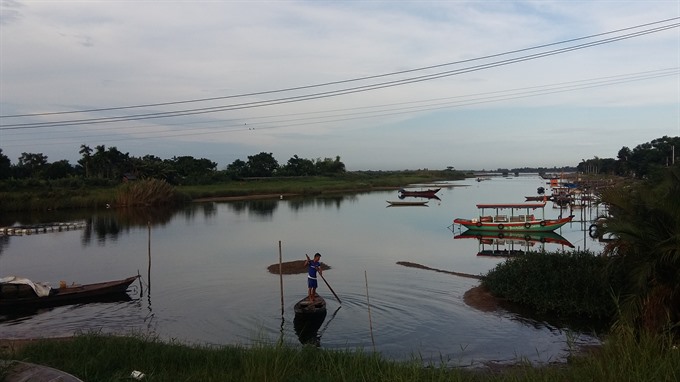 |
| The peaceful scenery of Triem Tay Village in Dien Ban Town of Quang Nam Province. — VNS Photo Cong Thanh |
Organic materials used to build the dyke include local grass, bamboo, cloth tubes of sand and reed clumps to anchor the soil that serves as the dyke’s foundation.
Mangrove (sonneratia caseolaris) was chosen to reduce water pressure breaker on the outer layer of the dyke.
“The mangrove can grow quickly, and its roots create a safe shelter for marine creatures, as well as reduce water pressure by allowing free space for water to come in and out easily,” she explained.
“It reduces the breaking force of high tide. Only water comes out through mangrove roots, but alluvial soil are retained. This means that the dyke is naturally reinforced by sand and mud every time the tide comes in.”
First loss
Dao and Hanh suffered their first setback during their first pilot project, when they planted the mangrove outside the dyke without an anchor. The 2017 flood, which soaked Triem Tay Village over a period of nine days—the longest flood in the village history—washed away the eight-month-old unanchored mangrove.
“We neglected to build a water shield on the outer layer. Mangrove needs at least two years to take strong root in the soil, but the unforeseen flood lashed the young mangrove,” Hanh recalled.
They learned from that mistake.
“The next time, we built a bamboo wall on the front layer to protect the mangrove in the initial period, while a strong local grass species was grown behind the mangrove layer to provide another layer to defend the river bank from erosion,” Hanh said.
The Hanoian said the structure of the dyke, modeled on a diverse forest, which was grown from casuarinas, bamboo and native bushes, has given the farm a strong defence against disaster.
She said a sapling garden of flood-resistant plants was built on the farm to create supplies that can be used to construct a larger green dyke in the future.
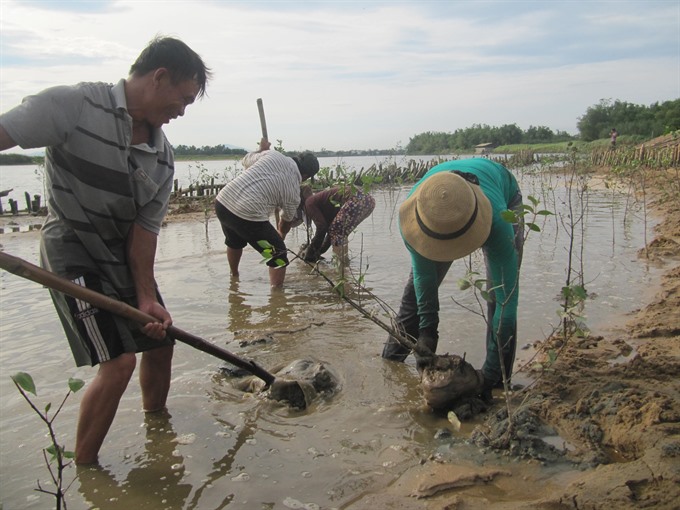 |
| Local residents grow mangrove along the bank of the Thu Bon River. — VNS Photo Cong Thanh |
Villager Vu Duc Sinh, a member of the village’s community-based eco-tourism co-operative, said he has witnessed serious erosion in the village for decades. Villagers did not know how to stop the floods from washing away the farmlands.
“As a rule, a heavy flood occurs every five years, but unpredictable water flow from the discharge of hydro-power plants and forest destruction in the riverheads caused the erosion to worsen,” Sinh said.
“The increasing erosions had jolted our lives, with farm lands narrowing each year due to larger and longer floods in recent decades,” Sinh said.
He said at least 50ha of farm land had been washed away by floods over two decades.
Technique
Concrete walls had been built to strengthen the village’s riverbanks, but erosion dug deeply into the soil at the bottom of the wall, severely damaging the structure.
Dao said concrete structure cannot defend a riverbank against long-term attacks of water.
That is why Dao chose organic materials like bamboo, logs and sandbags to anchor the green dyke.
“We divided the work into different sections, and each section connects to the other with plant layers. It’s the way a forest grows, and we just learnt how to build it from nature,” Dao said.
She said the green dyke development also involved the community, as they acknowledged the importance of riverbank protection.
A collection of 200 flora species have been raised at An Nhien Farm’s sapling garden to create sustainable supply for the green dykes.
Nguyen Thi Phuc Hoa, an expert in disaster and risk management, said An Nhien Farm’s green structure wall was a good example of a long term resilience solution to climate change.
She said the nature-based dyke will be an option for climate change-affected coastal areas in the future, as people learn to live with what were once regarded as disasters.
“Mangrove can live in brackish water and it can protect riverbanks from erosion during heavy floods and high tide. The forest-built dyke is based on the natural rule that flora can survive disaster,” Hoa said.
Hoa said Quang Nam Province had been boosting the development of mangrove forests and seeking sustainable ways of protecting the long coast line and wetland areas from forecast bigger disasters in the future.
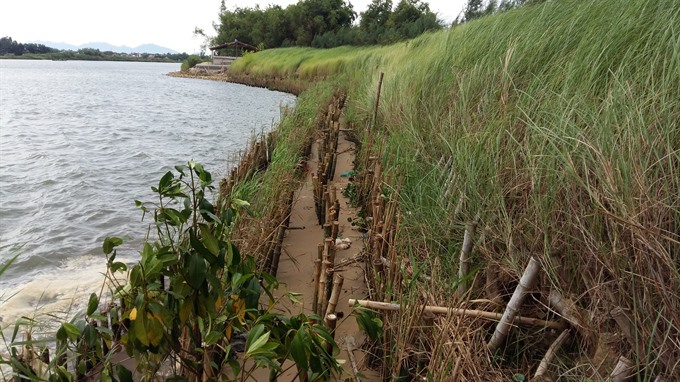 |
| Bamboo, mangrove, native grass and bushes are used to build a nature-based wall to protect riverbanks on An Nhien Farm, near Hoi An City. — VNS Photo Cong Thanh |
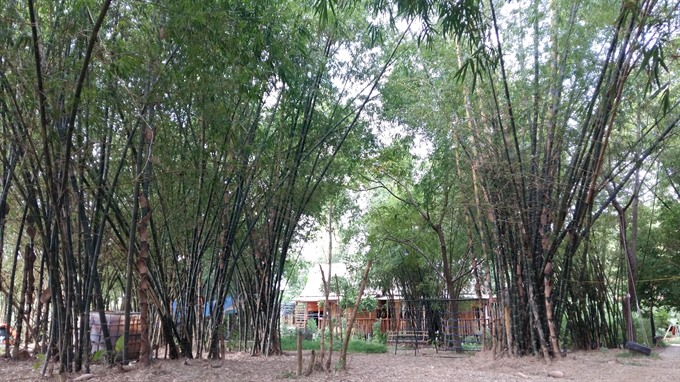 |
| Bamboo is grown in Triem Tay Village of Quang Nam Province. It creates rural scenery and wind-proof for villages in storm. — VNS Photo Cong Thanh |
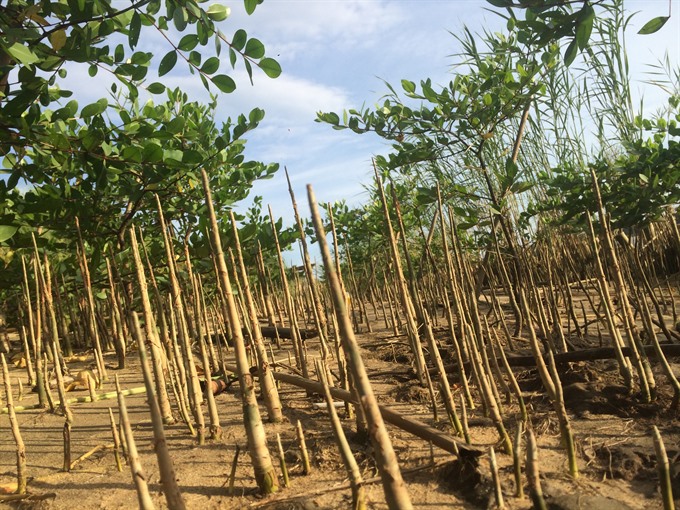 |
| Mangrove is newly grown along the Thu Bon River bank. The wetland plant helps reinforce the river banks with soil and mud. Photo courtesy of An Nhien Farm |
 |
| A staff member of An Nhien Farm plants a bush species in the middle of bamboo walls on the riverbank of Thu Bon. — VNS Photo Cong Thanh |
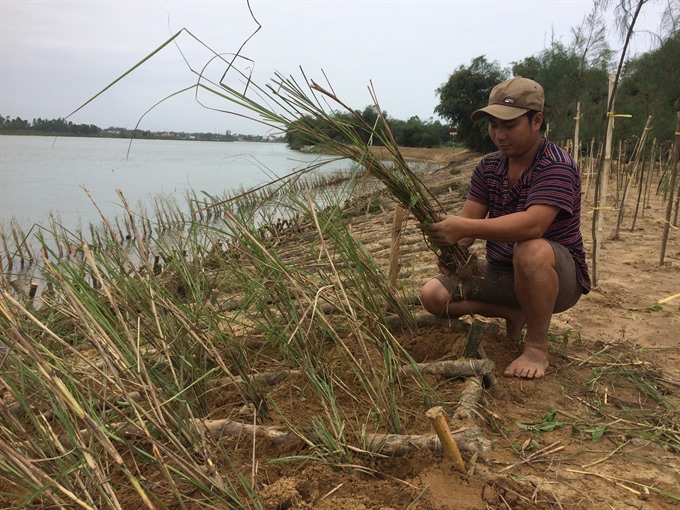 |
| Local grass is used to create roots for the log anchor structure on the body of the soil dyke. Photo courtesy An Nhien Farm |
‘Green’ development
The administration of ancient Hoi An City has been applying the green dyke solution for the worst eroded sections of the riverbank.
Nguyen The Hung, vice chairman of Hoi An City’s people’s committee, said the An Nhien Farm green dyke was seen as an effective and sustainable protection measure for the city’s riverbanks.
Hung said the city, in co-operation with the An Nhien Farm, began building a 700m green dyke section in connection with the farm’s already-built 250m soft dyke.
“We learned from the experience of An Nhien’s unprotected mangrove layer destroyed during the 2017 flood, so we set rock walls on the outside to protect the newly grown mangrove from damage. Mangrove needs to grow strong as it can protect the inner layers of the grass, bushes and soil dyke,” Hung said.
“The city plans to set up more green dyke sections to protect the most vulnerable eroded areas in Cam Kim and Cam Nam villages along the Thu Bon River,” he said, adding that the green dyke costs only a third of a concrete dyke.
Hung said the green dyke would help reduce the speed of high tide waves on the riverbanks, while roots retain alluvia to reinforce the base of the soil dyke.
He said Hoi An City had been seeking green and sustainable solutions to preserve the city and its landscape as an UNECO-recognised world heritage site.
"Hoi An’s old quarter and its river system is closely linked with the world biosphere of the Cham Islands, and sustainable preservation will be top priority of the city," he added.
Mastermind of the green dyke Dao said she hoped the solution would help Triem Tay Village’s dyke stand strong through future floods, and prevent erosion in the future.
“I keep growing more flood resistant plants for the long development of green riverbank protection in the most vulnerable sites in coastal areas in central Viet Nam. Please, behave tenderly towards nature, and we should learn to live with disaster softly,” she said. VNS
OVietnam